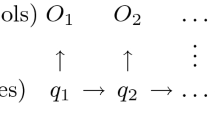Abstract
In this paper we develop a new algorithm for automatic taxonomy construction from a text corpus. In contrast to existing work, our objective is not to develop a general purpose lexicon or ontology but to identify the structure in a time–ordered sequence of documents. The idea is to identify “lead” words by which we are able to follow the common thread in the public discourse on a specific topic. Our taxonomy represents the backbone of the discourse (including names of protagonists and places) and may change over time. It is thus less rigid and universal than a lexicon and instead targets relationships that are valid in a given context. We present an example to illustrate the idea.
Access this chapter
Tax calculation will be finalised at checkout
Purchases are for personal use only
Similar content being viewed by others
Notes
- 1.
Adjacency pairs constitute the central organizing format in natural conversations. They consist of two turns by two different speakers which are relatively ordered. The so–called “first pair part” initiates the exchange whereas the “second pair part” responds by providing a relevant follow–up statement. In this paper, we assume that the responses are always “pair–type related”; by starting with a filtered sub–corpus we exclude improper pairings whose dialogue–equivalent would roughly read: “Would you like some tea?”–“Hi!” [21].
- 2.
This level of \(\theta _0\) is thus 1.5 times the row sum in the normalized matrix C.
References
Chu, Y.J.: On the shortest arborescence of a directed graph. Sci. Sin. 14, 1396–1400 (1965)
Clark, H.H., Marshall, C.R.: Definite reference and mutual knowledge. Psycholinguistics: Crit. Concepts Psychol. 414 (2002)
Cohen, T., Widdows, D.: Empirical distributional semantics: methods and biomedical applications. J. Biomed. Inform. 42(2), 390–405 (2009)
Downs, A.: Up and down with ecology-the issue-attention cycle. Public Interest 28, 38–50 (1972)
Edmonds, J.: Optimum branchings. J. Res. Natl. Bureau Stan. B 71(4), 233–240 (1967)
Fountain, T., Lapata, M.: Taxonomy induction using hierarchical random graphs. In: Proceedings of the 2012 Conference of the North American Chapter of the Association for Computational Linguistics: Human Language Technologies, pp. 466–476. Association for Computational Linguistics (2012)
Gabrilovich, E., Markovitch, S.: Computing semantic relatedness using Wikipedia-based explicit semantic analysis. In: IJCAI, vol. 7, pp. 1606–1611 (2007)
Gavins, J.: Text World Theory. Edinburgh University Press, Edinburgh (2007)
Gick, M.L., Holyoak, K.J.: Schema induction and analogical transfer. Cogn. Psychol. 15(1), 1–38 (1983)
Goffman, E.: Forms of Talk. University of Pennsylvania Press, Philadelphia (1981)
Grice, H.P.: Logic and conversation, pp. 41–58 (1975)
Gumperz, J.J.: Mutual inferencing in conversation. In: Mutualities in Dialogue, pp. 101–123 (1995)
Heritage, J.: Conversation analysis and institutional talk. In: Handbook of Language and Social Interaction, pp. 103–147 (2005)
Hovy, E.: Comparing sets of semantic relations in ontologies. In: Green, R., Bean, C.A., Myaeng, S.H. (eds.) The Semantics of Relationships, vol. 3, pp. 91–110. Springer, Heidelberg (2002). https://doi.org/10.1007/978-94-017-0073-3_6
Kozareva, Z., Hovy, E.: A semi-supervised method to learn and construct taxonomies using the web. In: Proceedings of the 2010 Conference on Empirical Methods in Natural Language Processing, pp. 1110–1118. Association for Computational Linguistics (2010)
Kozareva, Z., Riloff, E., Hovy, E.H.: Semantic class learning from the web with hyponym pattern linkage graphs. In: ACL, vol. 8, pp. 1048–1056 (2008)
Miller, G.A., Beckwith, R., Fellbaum, C., Gross, D., Miller, K.J.: Introduction to wordnet: an on-line lexical database. Int. J. Lexicography 3(4), 235–244 (1990)
Pantel, P., Pennacchiotti, M.: Espresso: leveraging generic patterns for automatically harvesting semantic relations. In: Proceedings of the 21st International Conference on Computational Linguistics, pp. 113–120. Association for Computational Linguistics (2006)
Pickering, M.J., Garrod, S.: Toward a mechanistic psychology of dialogue. Behav. Brain Sci. 27(02), 169–190 (2004)
Sacks, H., Schegloff, E.A., Jefferson, G.: A simplest systematics for the organization of turn-taking for conversation. Language 696–735 (1974)
Schegloff, E.A.: Sequence Organization in Interaction: Volume 1: A Primer in Conversation Analysis, vol. 1. Cambridge University Press, Cambridge (2007)
Stalnaker, R.: Common ground. Linguist. Philos. 25(5–6), 701–721 (2002)
Turner, J.C.: Social Influence. Thomson Brooks/Cole Publishing Co, Pacific Grove (1991)
Velardi, P., Faralli, S., Navigli, R.: Ontolearn reloaded: a graph-based algorithm for taxonomy induction. Comput. Linguist. 39(3), 665–707 (2013)
Author information
Authors and Affiliations
Corresponding author
Editor information
Editors and Affiliations
Rights and permissions
Copyright information
© 2018 Springer International Publishing AG, part of Springer Nature
About this paper
Cite this paper
Feiler, M.J. (2018). Following the Common Thread Through Word Hierarchies. In: Perner, P. (eds) Machine Learning and Data Mining in Pattern Recognition. MLDM 2018. Lecture Notes in Computer Science(), vol 10934. Springer, Cham. https://doi.org/10.1007/978-3-319-96136-1_13
Download citation
DOI: https://doi.org/10.1007/978-3-319-96136-1_13
Published:
Publisher Name: Springer, Cham
Print ISBN: 978-3-319-96135-4
Online ISBN: 978-3-319-96136-1
eBook Packages: Computer ScienceComputer Science (R0)




